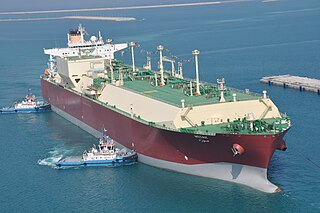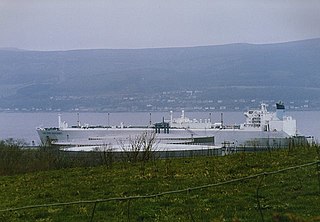Related Research Articles

The International Maritime Organization is a specialised agency of the United Nations responsible for regulating shipping. The IMO was established following agreement at a UN conference held in Geneva in 1948 and the IMO came into existence ten years later, meeting for the first time on 17 March 1958. Headquartered in London, United Kingdom, IMO currently has 175 Member States and three Associate Members.

The United States Merchant Marine is an organization composed of United States civilian mariners and U.S. civilian and federally owned merchant vessels. Both the civilian mariners and the merchant vessels are managed by a combination of the government and private sectors, and engage in commerce or transportation of goods and services in and out of the navigable waters of the United States. The Merchant Marine primarily transports domestic and international cargo and passengers during peacetime, and operate and maintain deep-sea merchant ships, tugboats, towboats, ferries, dredges, excursion vessels, charter boats and other waterborne craft on the oceans, the Great Lakes, rivers, canals, harbors, and other waterways. In times of war, the Merchant Marine can be an auxiliary to the United States Navy, and can be called upon to deliver military personnel and materiel for the military.

The International Convention for the Prevention of Pollution from Ships, 1973 as modified by the Protocol of 1978, or "MARPOL 73/78" is one of the most important international marine environmental conventions. It was developed by the International Maritime Organization with an objective to minimize pollution of the oceans and seas, including dumping, oil and air pollution.

A merchant ship, merchant vessel, trading vessel, or merchantman is a watercraft that transports cargo or carries passengers for hire. This is in contrast to pleasure craft, which are used for personal recreation, and naval ships, which are used for military purposes.
The International Convention for the Safety of Life at Sea (SOLAS) is an international maritime treaty which sets out minimum safety standards in the construction, equipment and operation of merchant ships. The International Maritime Organization convention requires signatory flag states to ensure that ships flagged by them comply with at least these standards.

A bulk carrier or bulker is a merchant ship specially designed to transport unpackaged bulk cargo—such as grain, coal, ore, steel coils, and cement—in its cargo holds. Since the first specialized bulk carrier was built in 1852, economic forces have led to increased size and sophistication of these ships. Today's bulk carriers are specially designed to maximize capacity, safety, efficiency, and durability.

Bulk cargo is commodity cargo that is transported unpackaged in large quantities.

A tanker is a ship designed to transport or store liquids or gases in bulk. Major types of tankship include the oil tanker, the chemical tanker, cargo ships, and a gas carrier. Tankers also carry commodities such as vegetable oils, molasses and wine. In the United States Navy and Military Sealift Command, a tanker used to refuel other ships is called an oiler but many other navies use the terms tanker and replenishment tanker. Tankers were first developed in the late 19th century as iron and steel hulls and pumping systems were developed. As of 2005, there were just over 4,000 tankers and supertankers 10,000 LT DWT or greater operating worldwide.

An LNG carrier is a tank ship designed for transporting liquefied natural gas (LNG).

Q-Max is a type of ship, specifically a membrane type LNG carrier. In the name Q-Max, "Q" stands for Qatar and "Max" for the maximum size of ship able to dock at the Liquefied natural gas (LNG) terminals in Qatar. Ships of this type are the largest LNG carriers in the world.

A hydrogen tanker or liquid hydrogen tanker is a tank ship designed for transporting liquefied hydrogen.

BP Shipping is the maritime arm of British headquartered global oil company, BP. The unit covers the marine transport, logistics and insurance requirements of all BP's global activities.

Gastor and Nestor were two LNG carriers built at the French shipyard Chantiers de l'Atlantique in Saint-Nazaire. Although delivered in 1976 both ships only entered real service in 1993, after their sale to Bonny Gas Transport Bermuda Shell, a subsidiary of Nigeria LNG Limited. Under their original names, the ships never transported any cargo.

A gas carrier, gas tanker, LPG carrier, or LPG tanker is a ship designed to transport LPG, LNG, CNG, or liquefied chemical gases in bulk.
The International Code for Ships Operating in Polar Waters or Polar Code is an international regime adopted by the International Maritime Organization (IMO) in 2014. The Code sets out regulations for shipping in the polar regions, principally relating to ice navigation and ship design. The international framework aims to protect the two polar regions — the Arctic and Antarctic, from maritime risks. The Code entered into force on 1 January 2017.

The HNS Convention is an international convention created in 1996 to compensate for damages caused by spillage of hazardous and noxious substances during maritime transportation. The convention is officially known as the International Convention on Liability and Compensation for Damage in Connection with the Carriage of Hazardous and Noxious Substances by Sea, 1996. The convention has not entered into force due to signatory states not meeting the ratification requirements. Canada, France, Germany, Greece, the Netherlands, Norway, and Turkey signed the 2010 protocol to the convention.

A marine LNG engine is a dual fuel engine that uses natural gas and bunker fuel to convert chemical energy in to mechanical energy. Due to natural gas' cleaner burning properties, the use of natural gas in merchant ship propulsion plants is becoming an option for companies in order to comply with IMO and MARPOL environmental regulations. The natural gas is stored in liquid state (LNG) and the boil-off gas is routed to and burned in dual fuel engines. Shipping companies have been cautious when choosing a propulsion system for their fleets. The steam turbine system has been the main choice as the prime mover on LNG carriers over the last several decades. The decades-old system on steam propelled LNG carriers uses BOG. LNG carriers are heavily insulated to keep the LNG at around -160 °C – to keep it liquefied. Despite insulation, the LNG containment area is penetrated by heat which allows for naturally generated boil-off gas (BOG).
Today Makes Tomorrow (TMT) is a Taiwanese shipping company that in 2008 directly owned some 60 ships, with many more on order, including dry bulk, crude, cargo, LNG, automobile, and cement carriers.

MV OS 35 is a bulk carrier registered in Tuvalu, a flag of convenience. The vessel first came into news when a piracy attack on her off the coast of Somalia was thwarted jointly by ships of China’s People’s Liberation Army Navy and of the Indian Navy.
The International Code of Safety for Ships Using Gases or Other Low-flashpoint Fuels, often referred and abbreviated as the IGF Code, is the International Maritime Organization (IMO) standard for the use of gases as a fuel in maritime transport.
References
- 1 2 Tanker Safety Training Liquefied Gas. Witherby Publishing Group. 2022. p. 13. ISBN 9781914992285.
- 1 2 "IGC Code". International Maritime Organization. Retrieved 5 July 2022.
- 1 2 3 Tanker Safety Training Liquefied Gas. Witherby Publishing Group. 2022. pp. 95–99. ISBN 9781914992285.
- ↑ "Emergency shutdowns on cargo systems". Insurance Marine News. Retrieved 5 July 2022.
- ↑ LNG Shipping Knowledge. Witherby Publishing Group. 2020. pp. 76–77. ISBN 9781856099035.
- ↑ "Group set to tackle IGC Code revisions". Tradewinds. Retrieved 5 July 2022.
- ↑ "Recent gas-related developments at IMO and EU". Safety4Sea News. Retrieved 5 July 2022.
- 1 2 LNG Shipping Knowledge. Witherby Publishing Group. 2020. p. 21. ISBN 9781856099035.
- ↑ "SOLAS Amendments Related to Costa Concordia Entering into Force". Maritime Executive. Retrieved 5 July 2022.
- ↑ "Whats new with SOLAS 2024". Hellenic Shipping News. Retrieved 5 July 2022.